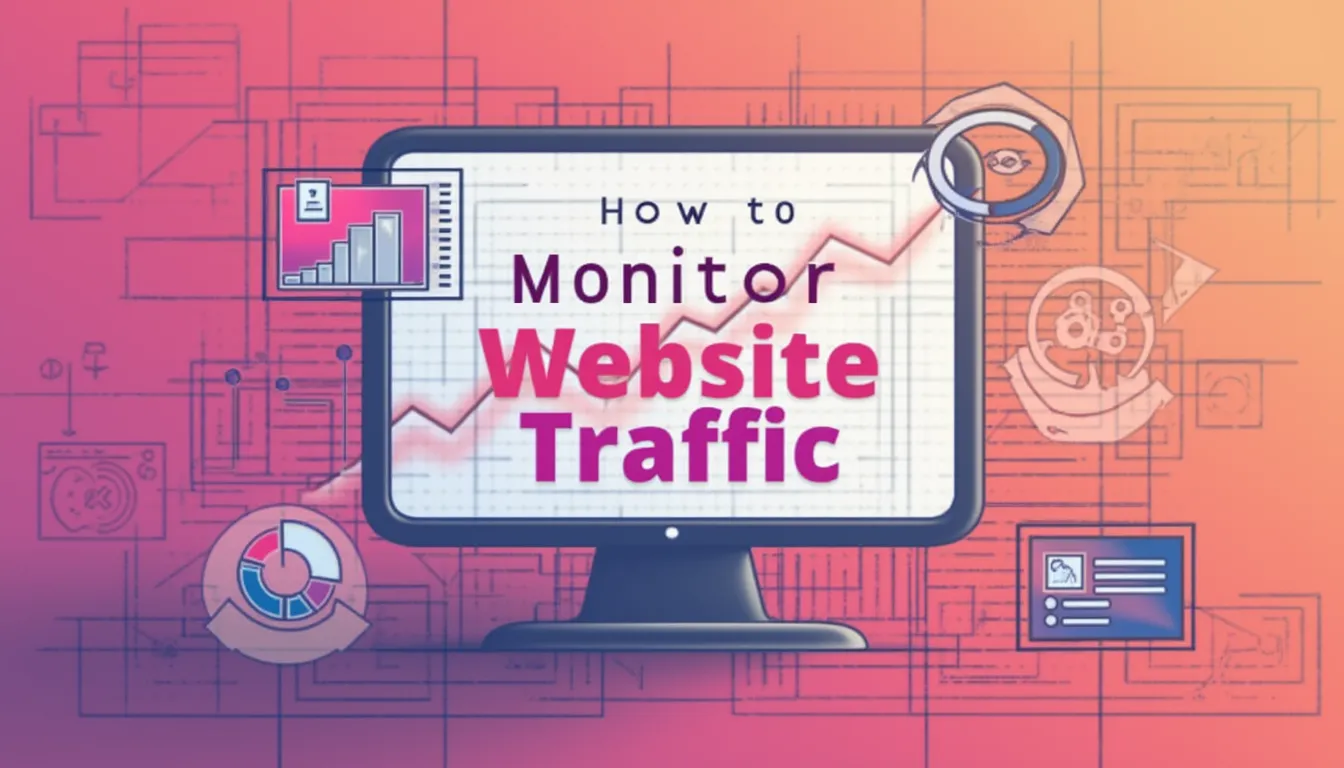
Understanding how to view website traffic is essential for improving your site’s performance. Tools like Google Analytics and Google Search Console provide valuable insights into where your visitors come from and how they interact with your content. These tools help you identify traffic sources, track real-time progress, and refine your marketing strategies.
Tracking website traffic also enhances user experience. By analyzing user behavior, you can address issues that might drive visitors away and create a more engaging site. Tools like Google Analytics allow you to monitor keyword performance and social media traffic, helping you boost your SEO rankings.
When you know how to view website traffic effectively, you can make data-driven decisions that improve your site’s visibility and user satisfaction.
Why Monitoring Website Traffic Matters
Benefits of Tracking Website Traffic
Understand audience demographics and preferences.
Tracking website traffic helps you learn more about your audience. Tools like Google Analytics provide data on age, gender, location, and interests. This information allows you to tailor your content and services to meet their needs. For example, if most of your visitors are from a specific region, you can create localized content to engage them better.
Identify popular content and pages.
Website traffic tools highlight which pages attract the most visitors. You can use this data to identify your top-performing content. Focus on replicating the success of these pages by creating similar topics or formats. This strategy ensures that you consistently deliver what your audience enjoys.
Detect and fix performance issues.
Monitoring traffic reveals potential problems on your site. High bounce rates or low session durations may indicate slow loading times or poor navigation. Addressing these issues improves user experience and keeps visitors on your site longer.
How Traffic Insights Impact Business Goals
Improve user engagement and retention.
Understanding traffic patterns helps you enhance user engagement. When you know which pages users spend the most time on, you can optimize those areas to keep them coming back. Engaged users are more likely to become loyal customers.
Boost conversions and revenue.
Traffic insights show how visitors interact with your site during their journey. You can identify drop-off points and optimize those areas to increase conversions. For instance, improving your checkout process can lead to higher sales.
Optimize marketing strategies.
Traffic data helps you evaluate the effectiveness of your marketing campaigns. You can see which channels drive the most visitors, whether it’s organic search, social media, or email. Use this information to allocate resources to the most successful platforms and refine your strategies for better results.
Best Website Traffic Tools to Check Website Traffic
Google Analytics
Overview of features and benefits.
Google Analytics is one of the most popular tools to check website traffic. It provides a comprehensive suite of features that help you monitor and analyze user activity on your site. You can track real-time reports to see live visitor actions, analyze conversion reports to measure the success of your campaigns, and use funnel analysis to understand user journeys. The tool also integrates seamlessly with other Google products, making it easier to manage your marketing efforts. Advanced features like tag management allow you to make smarter decisions based on data.
Free vs. premium versions.
The free version of Google Analytics is ideal for small to medium-sized websites. However, it has limitations. For example, data retention is capped at 14 months, and reporting quotas may restrict high-traffic sites. The premium version, Google Analytics 360, offers advanced customization, deeper analysis, and priority support. Businesses with large datasets benefit from its enhanced data processing capabilities and integration options. While the free version is sufficient for most users, upgrading to the premium version can provide more robust insights for scaling businesses.
Google Search Console
How it helps monitor search performance.
Google Search Console is another essential tool for tracking website traffic. It helps you monitor organic traffic, keyword rankings, and click-through rates. You can also check if your pages are indexed correctly and troubleshoot issues like mobile usability or security problems. The tool ensures your site meets Google’s standards for page experience and Core Web Vitals, which are crucial for search performance.
Key metrics like impressions and clicks.
Google Search Console provides valuable metrics to analyze your site’s performance. For example:
|
Metric |
Description |
|---|---|
|
Impressions |
Shows how often your site appears in search results. |
|
Clicks |
Tracks the number of times users click on your site from search results. |
|
Click Through Rate |
Measures the percentage of impressions that result in clicks. |
|
Position |
Displays the average ranking of your site in search results. |
These metrics help you identify areas for improvement and optimize your content for better visibility.
Third-Party Tools
Ahrefs: Competitive analysis and traffic insights.
Ahrefs is a powerful tool for analyzing website traffic and SEO performance. It allows you to track traffic trends, monitor backlinks, and analyze keyword rankings. You can also compare your site’s performance with competitors to identify opportunities for growth.
SimilarWeb: Website benchmarking and traffic sources.
SimilarWeb provides insights into market trends and traffic sources. It helps you benchmark your site against competitors and understand where your traffic comes from. This tool is especially useful for larger businesses looking to refine their strategies.
SEMrush: Comprehensive traffic analysis and SEO tools.
SEMrush offers a wide range of features, including domain analytics, keyword research, and content marketing tools. Its keyword research toolkit provides detailed insights into search intent and keyword clusters, saving you time and effort.
Ubersuggest: Free traffic estimates and keyword insights.
Ubersuggest is a budget-friendly option for small businesses. It provides free traffic estimates and keyword suggestions, making it a great starting point for those new to SEO.
How to Use Google Analytics to Track Website Traffic
What You Need
A Google account and access to your website’s backend.
To start using Google Analytics, you need a Google account. This account will allow you to access the Google Analytics platform. Furthermore, it is essential to have access to your website’s backend in order to implement the required tracking code. You cannot properly configure the tool to gather data without this backend access.
Google Analytics tracking code installed on your site.
The tracking code is essential for gathering data about your visitors. You must install this code on every page of your website. If the code is missing or incorrectly placed, Google Analytics will not track website traffic accurately. Ensure the tracking code remains intact during website migrations to avoid losing session data.
Step-by-Step Instructions
Log in to Google Analytics and navigate to the dashboard.
After creating your account, log in to Google Analytics. The dashboard is your central hub for all web analytics data. It provides an overview of your website’s performance, including traffic trends and user behavior.
Access the ‘Reports’ section for traffic insights.
The ‘Reports’ section contains detailed information about your audience and their activities. You can check website traffic metrics like sessions, users, and pageviews. This section also highlights traffic sources, helping you understand where your visitors come from.
Explore key reports like Audience, Acquisition, and Behavior.
The Audience report reveals demographic details about your visitors. The Acquisition report shows how users find your site through organic search, social media, or direct visits. The Behavior report tracks user interactions, such as time spent on pages and navigation patterns.
Set up goals and events to track specific user actions.
Goals and events help you measure important interactions, like form submissions or purchases. To set them up, identify key actions that align with your objectives. Use standard event names to unlock advanced reporting features. Test your setup with tools like Google Tag Assistant to ensure accuracy.
Common Challenges and Mistakes to Avoid
Misinterpreting metrics like bounce rate or session duration.
Bounce rate and session duration can be misleading if not analyzed correctly. For example, high exit rates on certain pages may skew average time on page. Always consider the context of these metrics to avoid incorrect conclusions.
Forgetting to filter out internal traffic.
Internal traffic from your team can distort your data. This leads to inaccurate insights and poor decision-making. Use filters in Google Analytics to exclude internal IP addresses from your reports.
Not setting up goals or custom reports.
Failing to configure goals or custom reports limits your ability to track meaningful interactions. Without these setups, you miss out on valuable insights into user engagement and conversions.
Understanding User Behavior Through Website Traffic Data
Key Metrics to Monitor
Sessions, users, and pageviews.
Sessions, users, and pageviews are foundational metrics in website traffic statistics. Sessions represent the total number of visits to your site, while users indicate the unique visitors. Pageviews show how often pages are viewed. Together, these metrics provide a snapshot of your website’s overall activity.
For example, a high number of sessions with low users might suggest repeat visits, which could indicate strong engagement.
Bounce rate and average session duration.
Bounce rate and average session duration reveal how visitors interact with your site. A high bounce rate may indicate that users leave after viewing only one page, possibly due to irrelevant content or poor design. Average session duration measures how long users stay on your site, reflecting their interest in your content.
|
Metric |
Description |
|---|---|
|
Average session duration |
Indicates how long users spend on the website, reflecting user engagement with the content. |
|
Bounce rate |
The percentage of users who leave after viewing only one page, indicating potential content issues. |
|
Scroll depth |
Measures how far users scroll down a page, helping to assess engagement with important elements. |
Traffic sources (organic, direct, referral, etc.).
Traffic sources help you understand where your visitors come from. Organic traffic comes from search engines, direct traffic occurs when users type your URL, and referral traffic comes from other websites. Monitoring these sources allows you to check website traffic patterns and refine your marketing strategies.
How to Interpret User Behavior
Identify patterns in user navigation.
Google Analytics helps you track website traffic and identify navigation patterns. For instance, you can see which pages users visit most often and how they move through your site. This insight helps you optimize the user journey.
Detect drop-off points in the user journey.
Drop-off points occur when users leave your site before completing an action. Tools like Google Analytics and Hotjar can highlight these areas. Addressing drop-offs by improving page design or content can enhance conversions.
Analyze engagement with specific content or features.
Analyzing website traffic data reveals how users interact with your content. Metrics like scroll depth and time on page show whether visitors engage with key elements. For example, if users stop scrolling before reaching a call-to-action, you may need to reposition it.
Common Concerns
What if my bounce rate is too high?
A high bounce rate can signal issues with your site. To address this, improve your user interface, simplify navigation, and ensure your content matches user intent. Strong headlines and accurate meta descriptions also help retain visitors.
How do I know if my traffic is growing consistently?
Consistent growth in website traffic statistics requires regular monitoring. Use tools like Google Analytics to compare traffic over time. Look for steady increases in sessions, users, and pageviews. If growth stalls, adjust your strategies to attract more visitors.
Tips for Improving Website Traffic and Engagement
Optimize for Search Engines (SEO)
Use relevant keywords and meta descriptions.
Search engines rely on keywords and meta descriptions to understand your content. Use relevant keywords that align with your audience’s search intent. Tools like google analytics can help you identify high-performing keywords. Write clear and engaging meta descriptions to encourage users to click on your links.
A strong meta description can improve your click-through rate and bring more visitors to your site.
Improve site speed and mobile responsiveness.
A fast-loading website keeps users engaged and reduces bounce rates. Compress images, enable browser caching, and minimize code to improve loading times. Mobile responsiveness is equally important. A mobile-friendly site ensures your content displays correctly on all devices. This improves user experience and boosts your search rankings.
Responsive design also enhances engagement signals, which search engines use to rank websites.
Create High-Quality Content
Focus on user intent and value.
Content that meets user needs attracts more visitors. Create articles, videos, or infographics that provide valuable information. For example, a blog post answering common questions in your industry can drive traffic.
Engaging content inspires action and builds trust with your audience.
Update and repurpose old content.
Repurposing old content can maximize its reach. Turn a blog post into a video or infographic to appeal to different audiences. Updating outdated information keeps your content relevant. This strategy helps you attract new visitors and retain existing ones.
Leverage Social Media and Email Marketing
Share content on social platforms.
Social media is a powerful tool for driving traffic. Share your content on platforms where your audience is most active. Create posts that encourage sharing and interaction. Optimizing your profiles with clear descriptions and links to your site can also improve visibility.
Build an email list and send regular updates.
Email marketing keeps your audience engaged. Build an email list by offering incentives like free resources or discounts. Send regular updates with links to your latest content.
Personalized emails can increase click-through rates and bring more visitors to your site.
Monitor and Adjust Strategies
Use A/B testing to refine user experience
A/B testing is a powerful way to improve your website’s user experience. It allows you to compare two versions of a webpage or feature to see which one performs better. This process helps you understand what resonates with your audience and what needs improvement. For example, testing two different headlines or button colors can reveal which option drives more clicks or conversions.
Key elements you can test include:
-
Headlines and copy
-
Calls to action (CTAs)
-
Navigation menus
-
Images and visuals
-
Forms and their fields
-
Page layout and design
-
User flow
Start small by testing one element at a time. For instance, if you want to increase sign-ups, experiment with different CTA button designs or placements. Use tools like Google Optimize or Optimizely to run these tests and gather data. Continuous testing ensures that your website evolves with user preferences, leading to higher engagement and satisfaction.
Regularly review traffic data and adjust accordingly
Website traffic data provides a wealth of information about your audience and their behavior. Regularly reviewing this data helps you identify trends, spot issues, and make informed decisions. Use tools like Google Analytics to monitor metrics such as sessions, bounce rate, and traffic sources.
Create a habit of analyzing your reports weekly or monthly. Look for patterns, such as a sudden drop in traffic or a spike in bounce rates. These changes often indicate areas that need attention. For example, if organic traffic decreases, you may need to revisit your SEO strategy or update outdated content.
Adjust your strategies based on the insights you gather. If referral traffic from social media is growing, focus more on those platforms. If users spend less time on certain pages, consider improving the content or design. Regular adjustments ensure your website stays relevant and continues to meet user expectations.
Monitoring website traffic helps you understand your audience and improve your website’s performance. Tools like Google Analytics and Google Search Console provide actionable insights into user behavior and traffic sources. Start using these tools to track website traffic and identify areas for growth.
Use the data to refine your strategies, enhance user experience, and achieve your business goals. Consistent tracking and analysis ensure your website stays competitive and meets your audience’s expectations.


